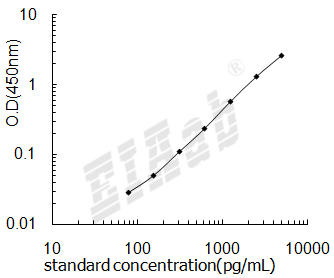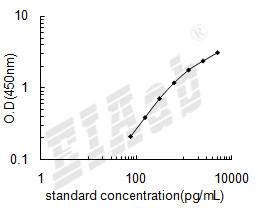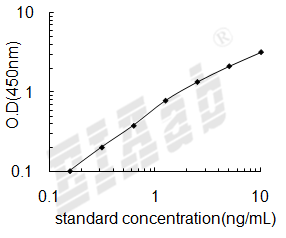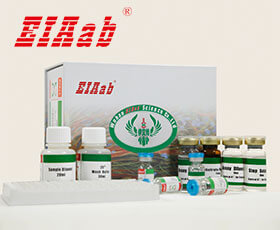Mdk (基因名), Midkine (蛋白名), MK_MOUSE.
产品名称:
Mouse Mdk/ Midkine ELISA Kit
肝素结合细胞因子
货号:
E0631m
商标:
EIAab®
监管等级:
别名:
Retanoic acid-responsive protein, Retinoic acid-induced differentiation factor, MK, Mk
检测方法:
ELISA
实验类型:
Sandwich
检测范围:
78-5000pg/mL
灵敏度:
39.6pg/mL
特异性:
Natural and recombinant mouse Midkine
样品类型:
Serum, plasma, tissue homogenates, cell culture supernates and other biological fluids
样品数据:
登录.
实验步骤:

研究领域:
Neurosciences
精密度
批内差:已知浓度的3个样本在一个板子内重复检测20次,以评估批内精密度。
批内 CV: ≤6.4%
批间差:已知浓度的3个样本在不同的板子上重复测定5次,以评估测定批间精密度。
批间 CV: ≤8.3%
批内 CV: ≤6.4%
批间差:已知浓度的3个样本在不同的板子上重复测定5次,以评估测定批间精密度。
批间 CV: ≤8.3%
回收率
回收率:低、中和高浓度的分析物被掺入到血清或者血浆样本中,进行回收实验测定。
|
Sample Type |
Average(%) |
Recovery Range(%) |
|
Serum |
87 |
81-93 |
|
Plasma |
89 |
83-95 |
线性
线性:给定样本通过梯度稀释,每次稀释的测量值与理论值的比值。
|
Sample |
1:2 |
1:4 |
1:8 |
1:16 |
|
serum(n=5) |
80-92% |
105-115% |
110-120% |
110-120% |
|
EDTA plasma(n=5) |
81-91% |
88-97% |
85-97% |
82-94% |
|
heparin plasma(n=5) |
106-117%
|
104-114% |
105-117% |
105-115% |
通用注释
亚单元:
Homodimer. Interacts with ALK. Interacts with LRP1; promotes neuronal survival. Interacts with LRP2. Interacts with NCAM1 (By similarity). Interacts (via C-terminal) with PTPRZ1 (via chondroitin sulfate chains); this interaction is inhibited by PTN; this interaction promotes neuronal migration (PubMed:10212223). Interacts with NCL; this interaction promotes NCL clustering and lateral movements of this complex into lipid rafts leading to MDK internalization. Interacts with LRP6 and LRP8: this interaction is calcium dependent. Interacts with ITGA4. Interacts with ITGA6. Interacts with ITGB1. Interacts with ITGA4:ITGB1 complex; this interaction mediates MDK-induced osteoblast cells migration through PXN phosphorylation. Interacts with ITGA6:ITGB1 complex; this interaction mediates MDK-induced neurite outgrowth. Interacts with NOTCH2; this interactio mediates a nuclear accumulation of NOTCH2 and therefore activation of NOTCH2 signaling leading to interaction between HES1 and STAT3. Interacts with GPC2 (via heparan sulfate chain); this interaction is inhibited by heparin followed by chondroitin sulfate E; this interaction induces GPC2 clustering through heparan sulfate chain; this interaction induces neuronal cell adhesion and neurite outgrowth (By similarity). Interacts with SDC3; this interaction induces SDC3 clustering; this interaction induces neuronal cell adhesion and neurite outgrowth (PubMed:9089390, PubMed:12084985). Interacts with SDC1 (PubMed:9089390). Interacts with CSPG5; this interaction promotes elongation of oligodendroglial precursor-like cells (PubMed:16901907).
功能:
Secreted protein that functions as cytokine and growth factor and mediates its signal through cell-surface proteoglycan and non-proteoglycan receptors (PubMed:16901907). Binds cell-surface proteoglycan receptors via their chondroitin sulfate (CS) groups (PubMed:17230638). Thereby regulates many processes like inflammatory response, cell proliferation, cell adhesion, cell growth, cell survival, tissue regeneration, cell differentiation and cell migration (PubMed:17230638, PubMed:19060126, PubMed:17015789, PubMed:28183532, PubMed:10683378, PubMed:15482347, PubMed:15509530, PubMed:24458438, PubMed:25551381, PubMed:29233575). Participates in inflammatory processes by exerting two different activities. Firstly, mediates neutrophils and macrophages recruitment to the sites of inflammation both by direct action by cooperating namely with ITGB2 via LRP1 and by inducing chemokine expression (PubMed:10683378, PubMed:15509530, PubMed:24458438, PubMed:28183532). This inflammation can be accompanied by epithelial cell survival and smooth muscle cell migration after renal and vessel damage, respectively (PubMed:15509530, PubMed:10683378). Secondly, suppresses the development of tolerogenic dendric cells thereby inhibiting the differentiation of regulatory T cells and also promote T cell expansion through NFAT signaling and Th1 cell differentiation (PubMed:28183532). Promotes tissue regeneration after injury or trauma. After heart damage negatively regulates the recruitment of inflammatory cells and mediates cell survival through activation of anti-apoptotic signaling pathways via MAPKs and AKT pathways through the activation of angiogenesis (PubMed:17015789, PubMed:19060126). Also facilitates liver regeneration as well as bone repair by recruiting macrophage at trauma site and by promoting cartilage development by facilitating chondrocyte differentiation (PubMed:15482347, PubMed:25551381). Plays a role in brain by promoting neural precursor cells survival and growth through interaction with heparan sulfate proteoglycans (PubMed:17230638). Binds PTPRZ1 and promotes neuronal migration and embryonic neurons survival (By similarity). Binds SDC3 or GPC2 and mediates neurite outgrowth and cell adhesion (By similarity). Binds chondroitin sulfate E and heparin leading to inhibition of neuronal cell adhesion induced by binding with GPC2 (PubMed:10978312). Binds CSPG5 and promotes elongation of oligodendroglial precursor-like cells (PubMed:16901907). Also binds ITGA6:ITGB1 complex; this interaction mediates MDK-induced neurite outgrowth (By similarity). Binds LRP1; promotes neuronal survival (By similarity). Binds ITGA4:ITGB1 complex; this interaction mediates MDK-induced osteoblast cells migration through PXN phosphorylation (By similarity). Binds anaplastic lymphoma kinase (ALK) which induces ALK activation and subsequent phosphorylation of the insulin receptor substrate (IRS1), followed by the activation of mitogen-activated protein kinase (MAPK) and PI3-kinase, and the induction of cell proliferation (By similarity). Promotes epithelial to mesenchymal transition through interaction with NOTCH2 (By similarity). During arteriogenesis, plays a role in vascular endothelial cell proliferation by inducing VEGFA expression and release which in turn induces nitric oxide synthase expression. Moreover activates vasodilation through nitric oxide synthase activation (PubMed:29233575). Negatively regulates bone formation in response to mechanical load by inhibiting Wnt/beta-catenin signaling in osteoblasts (PubMed:21185956, PubMed:20200993). In addition plays a role in hippocampal development, working memory, auditory response, early fetal adrenal gland development and the female reproductive system (PubMed:16619002, PubMed:17121547, PubMed:10096022).
亚细胞位置:
Secreted
该产品尚未在任何出版物中被引用。
[1].
小鼠肝素结合细胞因子(Mdk)ELISA试剂盒可以做多少个样本?
小鼠肝素结合细胞因子(Mdk)ELISA试剂盒分为2种规格,96孔和48孔。96孔的试剂盒,标曲和样本都做复孔的话,可以检测40个样本。96孔的试剂盒,标曲和样本都不做复孔的话,可以检测88个样本。
[2].
小鼠肝素结合细胞因子(Mdk)ELISA试剂盒使用视频?
小鼠肝素结合细胞因子(Mdk)ELISA试剂盒实验操作视频在以下网址中,对每一步的实验步骤都做了演示,方便实验员能更好地理解ELISA实验的过程。
https://www.eiaab.com.cn/lesson-tech/805.html
https://www.eiaab.com.cn/lesson-tech/805.html
[3].
小鼠肝素结合细胞因子(Mdk)ELISA试剂盒是放在-20℃冰箱保存吗?
EIAab的小鼠肝素结合细胞因子(Mdk)ELISA试剂盒,洗涤液、底物、终止液保存于4℃,其余试剂-20℃冰箱保存。
[4].
小鼠肝素结合细胞因子(Mdk)ELISA试剂盒原理?
双抗体夹心法:用纯化的抗体包被微孔板,制成固相抗体,往包被有固相抗体的微孔中依次加入标准品或受检样本、生物素化抗体、HRP标记的亲和素,经过彻底洗涤后用底物TMB显色。用酶标仪在450nm波长下测定吸光度(OD值),计算样本浓度。
竞争法:用纯化的抗体包被微孔板,制成固相抗体,往包被有固相抗体的微孔中依次加入标准品或受检样本和生物素标记的目标分析物,受检标本中抗原与生物素标记抗原竞争结合有限的抗体。再加入HRP标记的亲和素,经过彻底洗涤后用底物TMB显色。用酶标仪在450nm波长下测定吸光度(OD值),计算样本浓度。
竞争法:用纯化的抗体包被微孔板,制成固相抗体,往包被有固相抗体的微孔中依次加入标准品或受检样本和生物素标记的目标分析物,受检标本中抗原与生物素标记抗原竞争结合有限的抗体。再加入HRP标记的亲和素,经过彻底洗涤后用底物TMB显色。用酶标仪在450nm波长下测定吸光度(OD值),计算样本浓度。
[5].
小鼠肝素结合细胞因子(Mdk)ELISA试剂盒中需要使用的样品量是多少?
夹心法100μL/孔,竞争法50μL/孔。如样本浓度过高时,应对样本进行稀释,以使稀释后的样本符合试剂盒的检测范围,计算时再乘以相应的稀释倍数。
[6].
如何分析小鼠肝素结合细胞因子(Mdk)ELISA试剂盒数据?
建议标准曲线,并计算样本浓度。对于elisa的曲线拟合,一般建议采用4参数曲线拟合,4参数曲线拟合通常更适合免疫分析。推荐使用专业软件进行曲线拟合,例如curve expert 1.3。根据样本的OD值由标曲查出相应的浓度,再乘以稀释倍数;或用标准物的浓度与OD值计算出标曲的回归方程式,将样本的OD值代入方程式,计算出样本浓度,再乘以稀释倍数,即为样本的实际浓度。以下链接是curve expert 1.3软件拟合曲线的方法。
https://www.eiaab.com.cn/news/502/
https://www.eiaab.com.cn/news/502/
[7].
小鼠肝素结合细胞因子(Mdk)ELISA试剂盒中是否包含人和动物的副产物,是否包含感染的或者传染性原料如HIV等?
除了抗体和稀释液中的BSA,不含其它人和动物的副产物,也不含感染材料。
[8].
收集小鼠肝素结合细胞因子(Mdk)ELISA试剂盒血浆样本,用什么作为抗凝剂?
一般建议用EDTA和肝素作为抗凝剂。
[9].
小鼠肝素结合细胞因子(Mdk)ELISA试剂盒酶标板可以拆成几部分?拆的时候是否需要避光,无菌?
小鼠肝素结合细胞因子(Mdk)ELISA试剂盒酶标板是8×12孔条,可拆卸,板子可以拆成12条,注意避免孔污染,不需要避光和无菌。暂时不用的板子,放回原来装的袋子里,密封保存。
[10].
小鼠肝素结合细胞因子(Mdk)ELISA试剂盒样本如何保存?
尽量检测新鲜样本。若无新鲜样本,则4℃保存1周,-20℃保存1个月,-80℃保存2个月。
反馈墙
评论数 : 0
所有用户
所有用户
默认排序
默认排序
最近
早期
目前还没有评论。






通知
规格
数量
单价 (¥)
小计 1 (¥)
小计 2:
¥

规格
数量
单价 (¥)








 验证序列:
验证序列:




 折扣:
折扣: